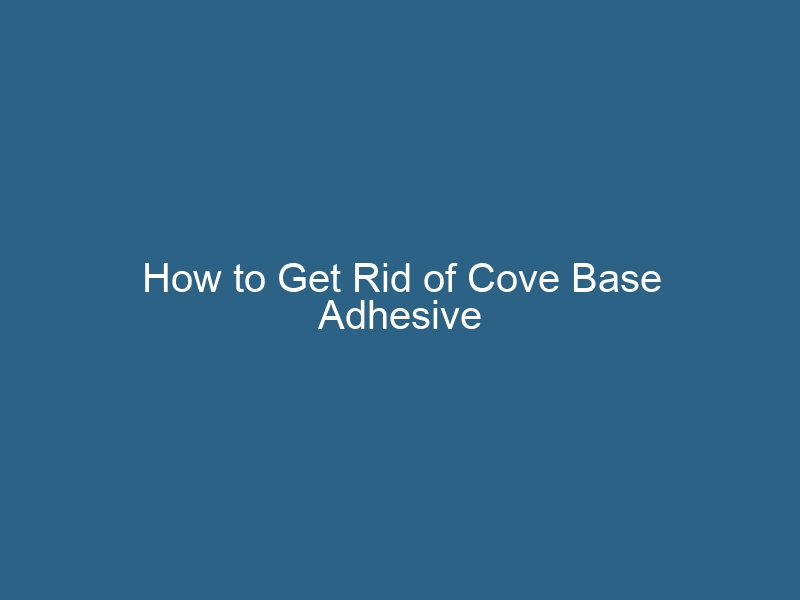Quck answer
To remove cove base adhesive, follow these steps:
1. Gather your materials: a putty knife, adhesive remover or warm soapy water, a sponge or cloth, and a bucket.
2. Start by using the putty knife to gently scrape off any loose adhesive.
3. If the adhesive is stubborn, apply adhesive remover directly to the area and let it sit for a few minutes to loosen the adhesive.
4. Once the adhesive has softened, use the putty knife to scrape it off. Be careful not to damage the wall or floor surface.
5. If you prefer a more natural method, mix warm soapy water and apply it to the adhesive. Let it sit for a few minutes, then use the putty knife to scrape it off.
6. After removing the adhesive, clean the area with a sponge or cloth and warm soapy water to remove any residue.
Remember to always follow the instructions on the adhesive remover product and take proper safety precautions.
Cove base adhesive is useful for attaching a white rubber baseboard to finish a basement wall, attach ceiling tiles to drywall, or complete other home improvement projects that enhance the appearance and functionality of a room.
However, sometimes you may encounter problems with old adhesive when applying the sticky substance or painting a vinyl wall base. But don’t worry: there are a few methods to remove the strong resin.
Cove Base Adhesive
A wall base connects the wall and the floor in a smooth line. The cove base adhesive is used to attach the white baseboard or wall base, which is typically made of vinyl or rubber.
Cove base adhesive is a wet-set glue that is used for installing rubber and vinyl cove base. A good cove base adhesive will bond easily and cleanly to sound, smooth drywall surfaces, ceilings, and flooring.
The adhesive ensures good contact between the drywall or ceiling tiles. Most cove base adhesives are made from latex acrylic, which makes them easy to install and clean up any excess that squeezes out from the wall base.
Preparing for Application
Cove base adhesive is a messy, industrial-grade substance that comes with a few hazards. When working with cove base adhesive, there are certain precautions to take to ensure your safety. Any potentially harmful substance should be handled with care.
A solvent-based adhesive is flammable, so any tools, drills, or other electric devices should be closely monitored when in use. It can also burn the skin, so always wear gloves and wraparound safety glasses. Wear long sleeves, closed-toed shoes, and long pants to prevent the adhesive from coming into contact with your skin.
Cove base adhesives are made from volatile organic compounds, which can be a serious problem if they are accidentally inhaled. Wear a mask and make sure the area where you are working is well ventilated.
How to Remove Wet Cove Base Adhesive
Removing vinyl baseboard glue is not difficult if it was recently applied. Have rags and a simple soap and water solution on hand to remove adhesive that ends up in unwanted places.
To remove wet cove base adhesive, prepare a bucket of warm water and dishwashing liquid. Use a wet, soapy rag to wipe away the adhesive. It may take a few swipes before the glue is completely removed and the area is clean.
Once the adhesive has been removed, allow the area to dry completely before continuing to work on the floor, wall, or ceiling.
Removing Hardened Cove Base
If you need to remove hardened cove base, you will need to use stronger cleaners. An affordable and easily accessible household cleaner can be used to remove the adhesive, and it is not difficult to work with. Denatured alcohol is effective in breaking down hardened cove base adhesive.
Apply a layer of rubbing alcohol to the cove base. Apply it generously to the adhesive and allow it to penetrate. After a few minutes, the adhesive will soften and be easier to wipe up or peel off.
Getting Rid of Difficult Cove Base
For challenging or thick areas of stubborn adhesive, a commercial cove base adhesive is effective. Simply apply it by wiping it onto the unwanted glue, ensuring that the adhesive is completely moist. If it starts to dry, reapply promptly.
The obstinate patches of adhesive will eventually transform into a gel-like substance that can be rolled up using a clean cloth.
Use water to rinse the affected area. Remove any remaining adhesive residue and solvent, and allow the area to completely dry before proceeding with new materials.


